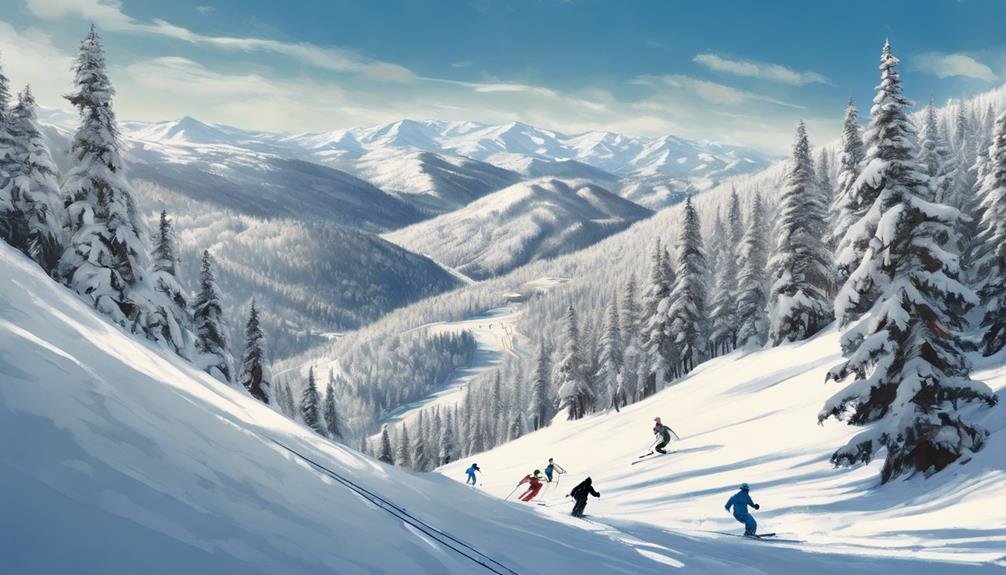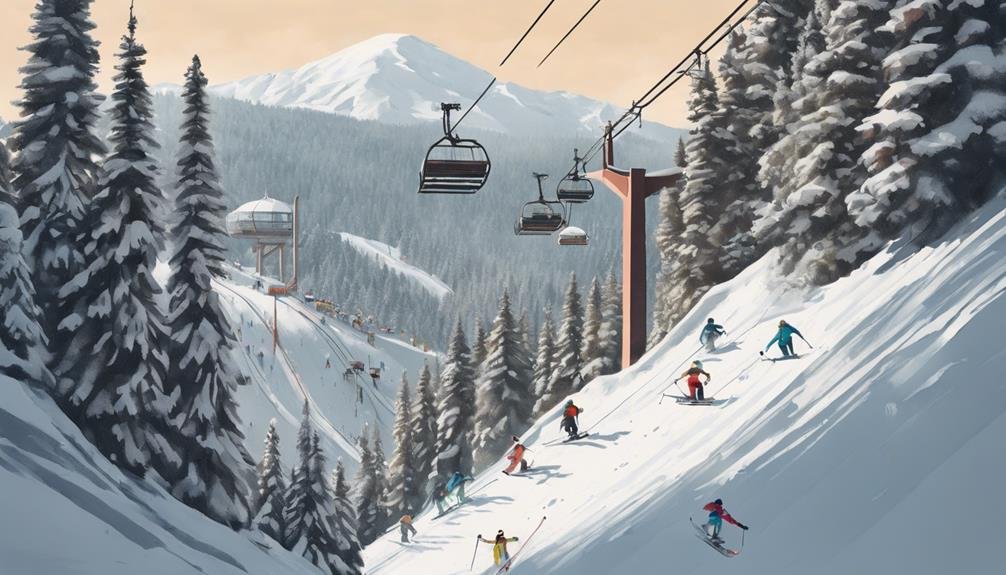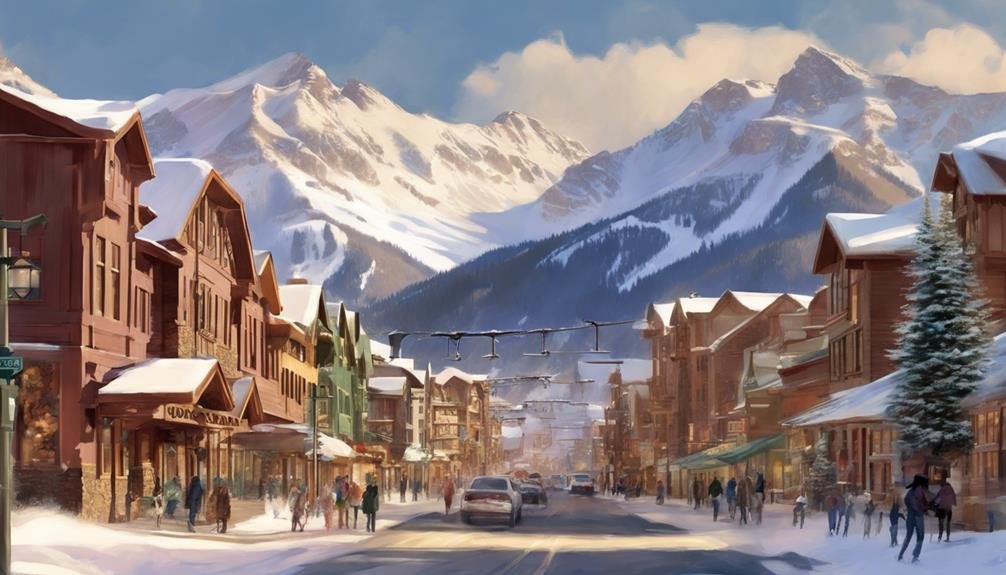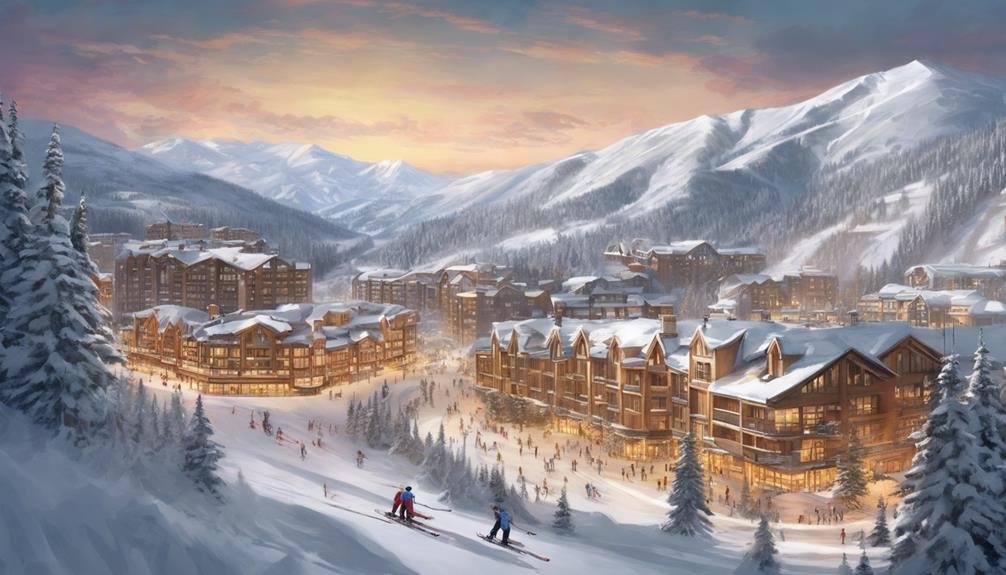Introduction
Nestled in the heart of the Rocky Mountains in Colorado, Vail Ski Resort is a haven for winter sports enthusiasts from around the globe. Known for its expansive skiable terrain, world-class amenities, and vibrant village life, Vail offers an unparalleled skiing experience.
But to truly enjoy what Vail has to offer, it’s crucial to understand the concept of ski conditions. Ski conditions refer to the state of the snow and weather on the slopes. They can greatly influence not only your safety but also the quality of your skiing experience. From the type and amount of snow to visibility and temperature, ski conditions can vary widely and have a significant impact on your day on the mountain.
In the following sections, we’ll delve deeper into the typical ski conditions at Vail, how to interpret them, and how to prepare for your visit to this iconic resort. Whether you’re a seasoned skier or a first-time visitor, this guide will help you make the most of your time at Vail Ski Resort. Let’s get started!
Understanding Ski Conditions
Ski conditions are a crucial aspect of any ski trip and understanding them can greatly enhance your experience on the slopes. But what exactly are ski conditions?
In essence, ski conditions refer to the state of the snow and the weather on the ski slopes. They encompass a variety of factors, including snow quality (such as powder, packed powder, hard pack, or icy), snow depth, weather (like sunny, overcast, or snowy), and temperature. These conditions are dynamic and can change rapidly, influenced by weather patterns, time of day, and even skier traffic.
Why are ski conditions so important? Well, they directly change your skiing experience. Good conditions, like fresh powder and clear skies, can make for an exhilarating day on the slopes. On the other hand, challenging conditions such as icy patches or poor visibility can test your skills and require extra caution.
Moreover, ski conditions can affect the difficulty of the trails. A run that is easy and enjoyable in powder can become much more challenging when it’s icy. Therefore, understanding ski conditions can help you choose the right trails for your skill level and ensure a safe and enjoyable skiing experience.
In the context of Vail Ski Resort, given its location in the Colorado Rockies and its high altitude, it typically experiences a range of ski conditions throughout the season. By understanding these conditions, you can better plan your trip and make the most of your time on Vail’s world-class slopes. In the following sections, we’ll delve deeper into the typical ski conditions at Vail and how to prepare for them. Stay tuned!
Vail Ski Resort: An Overview
The Birth of a Skiing Mecca
Vail Ski Resort, nestled in the heart of the Colorado Rockies, is more than just a ski resort – it’s a testament to vision, perseverance, and love for the great outdoors. The resort’s story began in the early 1960s when Pete Seibert, a World War II veteran, and Earl Eaton, a local rancher, dreamt of creating a world-class ski resort. Their dream became a reality in 1962 when Vail Mountain opened to the public, forever changing the landscape of winter sports in the United States.
A Resort Like No Other
Fast forward to today, Vail Ski Resort has grown into one of the largest and most popular ski destinations in North America. With a skiable terrain of over 5,300 acres, it boasts a diverse range of trails suitable for all skill levels, from gentle beginner slopes to challenging back bowls.
But skiing is just the tip of the iceberg when it comes to what Vail has to offer. The resort is also renowned for its vibrant village life. Modeled after traditional European ski towns, Vail Village is a hub of activity with a plethora of dining, shopping, and entertainment options.
Embracing the Future
As Vail Ski Resort looks to the future, it continues to innovate and improve. Recent years have seen significant investments in modernizing lifts, expanding terrain, and enhancing snowmaking capabilities. These efforts ensure that Vail stays at the forefront of the ski industry, offering visitors an unmatched skiing experience.
In the following sections, we’ll delve deeper into the typical ski conditions at Vail and how to prepare for them. Whether you’re planning your first trip to Vail or you’re a seasoned visitor, this guide will help you make the most of your time at this iconic resort. Stay tuned!
General Ski Conditions at Vail
A Seasonal Symphony
Vail Ski Resort, with its high altitude and location in the Colorado Rockies, experiences a variety of ski conditions throughout the year. The resort’s ski season typically begins in mid-November and extends through mid-April, offering a wide range of conditions that can transform the mountain’s terrain.
In the early season, from November to early December, you can expect a mix of synthetic and natural snow. The temperatures are usually low, which is ideal for snowmaking. The trails during this time are often less crowded, providing a great opportunity for those looking to enjoy the slopes at a leisurely pace.
As the season progresses into the heart of winter, from late December through February, Vail often sees frequent snowfall, leading to excellent powder conditions. This is the time when the mountain truly comes alive, with all trails and lifts typically in operation.
Spring skiing, from March to mid-April, brings warmer temperatures and a mix of conditions. Mornings often start with firm snow that softens into slush in the afternoon sun. This is also the time for fun spring events and festivities at the resort.
The Impact of Ski Conditions
Understanding these general ski conditions is crucial as they can significantly affect your skiing experience. For instance, powder days offer a unique thrill for experienced skiers, while groomed runs are often preferred by beginners. Similarly, visibility can vary with changing weather conditions, affecting your ability to navigate the slopes.
It’s also worth noting that conditions can vary across the mountain. The Back Bowls, for example, are known for their deep powder after a snowstorm, while the front side of the mountain might offer more groomed runs.
In the following sections, we’ll provide tips on how to prepare for these conditions and make the most of your visit to Vail Ski Resort. Stay tuned!
Interpreting Ski Conditions
Decoding the Language of the Slopes
Interpreting ski conditions is a bit like learning a new language. It involves understanding various terms and what they mean in the context of skiing. Here’s a deeper look into these terms:
Powder:
This is fresh, newly fallen snow that hasn’t been compacted. It’s light and fluffy, providing a smooth and enjoyable skiing experience. Skiers often use the term “powder day” to describe a day after heavy snowfall when the slopes are covered in fresh powder.
Packed Powder:
This is snow that has been compressed and packed down, either by the skis and snowboards of other resort guests or by grooming machines. Packed powder provides a firm but still relatively soft surface for skiing, making it ideal for carving turns.
Hard Pack:
This is snow that has been packed down very tightly, making it harder than packed powder. Hard pack can be more challenging to ski on because it’s less forgiving and requires more effort to carve turns.
Icy:
When the surface is hard and slick, it’s described as icy. Icy conditions can make skiing more challenging and potentially dangerous, especially for beginners, as it’s harder to gain traction and control on ice.
Wet Snow:
This is snow that is nearing the point of melting. It’s often sticky and heavy, which can slow you down and make turning more difficult. Wet snow is common in the spring or on warmer days.
Slush:
Slush is snow that has partially melted and refrozen. It can be heavy and wet, making skiing more challenging. Slush is common in the spring when temperatures rise above freezing.
Groomed Run:
A trail that has been smoothed out with a machine, often resulting in corduroy-like lines in the snow. Groomed runs are typically easier to ski on, especially for beginners.
Off-Piste:
This term refers to any area that is not a designated, groomed run. Off-piste areas can offer a variety of snow conditions, from deep powder to hard pack or ice, depending on recent weather.
Corn:
This is a term for a specific type of spring snow. After a cycle of melting during the day and refreezing at night, the snow forms into small, loose granules that resemble kernels of corn. Corn snow is soft and easy to ski on, making it a favorite among spring skiers.
Understanding these terms can help you expect the kind of experience you might have on the slopes. For example, ‘powder’ refers to fresh, fluffy snow that’s often sought after by skiers for its soft and smooth skiing experience. On the other hand, ‘icy’ conditions can make the slopes slippery and more challenging to navigate.
Tailoring Your Skiing to the Conditions
Ski conditions can also influence the choice of trails for skiers of different skill levels. Beginners might find ‘packed powder’ conditions on groomed runs more manageable, while advanced skiers might seek out ‘powder’ conditions in off-piste areas for a more challenging experience.
It’s also important to note that ski conditions can change throughout the day. Morning conditions might be different from afternoon conditions, especially on sunny days when the sun can soften the snow. Being aware of these changes and adapting to them can help enhance your skiing experience.
In the next section, we’ll discuss how to prepare for various ski conditions at Vail Ski Resort. Stay tuned!
Preparing for Vail’s Ski Conditions
Gear Up for the Adventure
Preparing for ski conditions at Vail starts with having the right gear. Depending on the conditions, you might need different types of skis or snowboards, as well as varying layers of clothing. For powder conditions, wider skis or a snowboard with a larger surface area can help you float on top of the snow. For icy or hard pack conditions, narrower skis with sharp edges can provide better grip.
Clothing is another important aspect of preparation. Dressing in layers can help you adjust to changing temperatures throughout the day. Don’t forget essentials like a good pair of ski socks, gloves, and goggles that can protect your eyes from glare and snow.
Safety First
Safety should always be your top priority when skiing. This means knowing your limits, staying on marked trails, and skiing in control. It’s also important to be aware of the risks associated with different ski conditions. For example, powder conditions can increase the risk of avalanches in off-piste areas, while icy conditions can lead to falls and injuries.
Take a Lesson
If you’re new to skiing or unfamiliar with the conditions at Vail, consider taking a lesson. Vail Ski Resort offers a variety of lessons for all skill levels, and professional instructors can provide valuable tips on how to handle different ski conditions.
Stay Informed
Finally, always check the latest ski report before heading out. This will give you an idea of what to expect on the slopes and help you plan your day accordingly.
Remember, skiing is all about having fun and enjoying the great outdoors. With the right preparation, you can have a fantastic time at Vail Ski Resort, no matter what the conditions are.
Stay tuned for the next section where we’ll discuss accommodations at Vail Ski Resort!
Accommodations at Vail Ski Resort
A Home Away from Home
Vail Ski Resort is not just about world-class skiing. It’s also about the incredible accommodations that make your stay comfortable, convenient, and memorable. The resort offers a wide range of accommodations to suit every taste and budget. From luxurious hotels to cozy condos and private vacation homes, there’s something for everyone.
Luxury Accommodations
For those seeking luxury, Vail does not disappoint. One of the standout options is the Christiania Lodge. Located in the heart of Vail Village, this charming, Bavarian-style lodge offers a warm, intimate atmosphere with personalized service.
Another top-tier choice is the Ritz Carlton Vail. With its elegant rooms, top-notch amenities, and impeccable service, the Ritz Carlton offers a truly luxurious stay. Plus, its location at the base of Vail Mountain means you’re just steps away from the gondola.
Other Noteworthy Options
There are also numerous other hotels that offer a great mix of comfort, convenience, and value. Many of these accommodations offer ski-in/ski-out access, making it easy to get on and off the slopes. Plus, they often feature amenities like heated pools, hot tubs, and on-site restaurants for you to enjoy after a day of skiing.
For those on a budget, there are several affordable options available:
- Super 8: Known for its affordability, Super 8 offers comfortable accommodations with essential amenities like free breakfast, Wi-Fi, and parking. Some locations are also pet-friendly.
- Travelodge: Another budget-friendly way, Travelodge provides comfortable rooms, free Wi-Fi, and complimentary breakfast at most locations. Some Travelodge hotels also have pools and fitness centers.
- Econo Lodge Inn & Suites: Part of the Choice Hotels family, Econo Lodge Inn & Suites offers simple and clean rooms, free Wi-Fi, and a continental breakfast. Some properties also feature pools and laundry facilities.
Remember, choosing the right accommodation can greatly enhance your Vail Ski Resort experience. Consider your needs, preferences, and budget when making your choice.
Stay tuned for the next section where we’ll discuss making the most of your Vail experience
Making the Most of Your Vail Experience
Maximizing Your Skiing Experience
To make the most of your skiing experience at Vail, it’s important to choose the right trails for your skill level and the current conditions. Remember, conditions can change throughout the day, so be sure to check the latest ski report and adjust your plans accordingly. Don’t be afraid to explore different parts of the mountain – Vail is known for its diverse terrain, from groomed runs to challenging back bowls.
Also, consider taking a lesson if you’re looking to improve your skills or if you’re new to skiing. Vail’s ski school offers a range of lessons for all ages and skill levels, and it’s a great way to gain confidence on the slopes.
Beyond the Slopes: Activities and Attractions at Vail
But Vail is not just about skiing. The resort offers a wealth of other activities and attractions to enjoy. You can explore the shops and restaurants in Vail Village, take a scenic gondola ride, or even try your hand at other winter sports like snowboarding and snowshoeing.
And after a day on the slopes, nothing beats relaxing by the fire at one of Vail’s many lodges or enjoying a hot tub soak with a view of the mountains.
Remember, a trip to Vail Ski Resort is what you make of it. Whether you’re there for the skiing, the scenery, or the après-ski, there’s no shortage of ways to create unforgettable memories.
Stay tuned for the conclusion of this guide where we’ll recap the importance of understanding ski conditions and how to make the most of your Vail Ski Resort experience!
Conclusion
Understanding ski conditions is a crucial part of planning and enjoying a ski trip. It helps you predict what to expect on the slopes, choose the right trails for your skill level, and prepare adequately for your skiing adventure.
Vail Ski Resort, with its diverse terrain and typical Colorado mountain weather, offers a variety of ski conditions throughout the season. From fresh powder to packed powder, hard pack, and spring slush, each type of condition offers a unique skiing experience.
Whether you’re a seasoned skier or a first-time visitor, being aware of these conditions and knowing how to interpret them can greatly enhance your skiing experience. And remember, no matter the conditions, safety should always be your top priority.
Beyond the slopes, Vail Ski Resort offers a wealth of other attractions and activities, from its vibrant village life to a range of accommodations to suit every taste and budget. So, even if the ski conditions aren’t perfect, there’s always something to enjoy at Vail. So, gear up, stay safe, and get ready to make the most of your Vail Ski Resort experience. Happy skiing!





